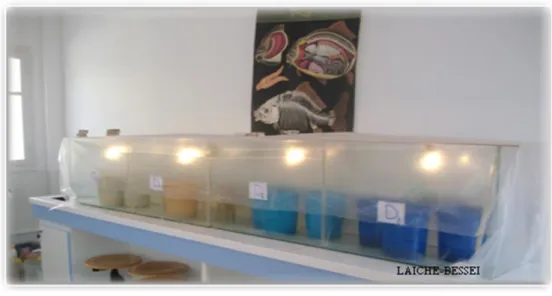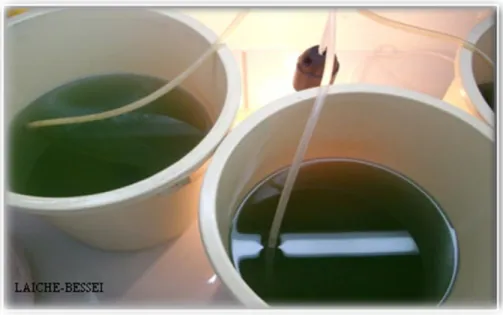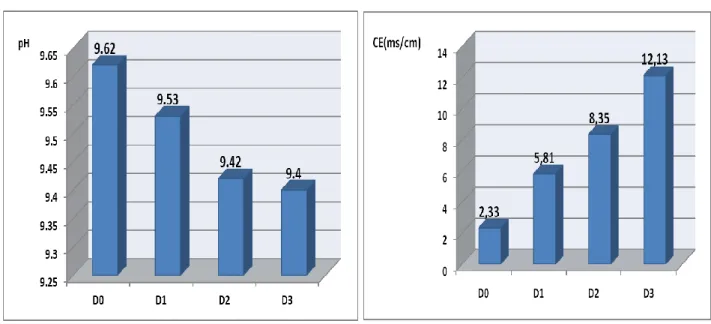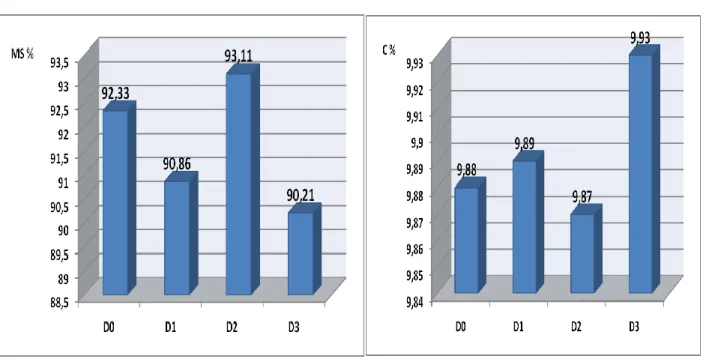37
Influence of salt stress on the mineral composition of Arthrospira platensis grown in an extreme environment in southern Algeria
Ammar Touhami LAICHE 1*, Abdelmalek BESSEI1
1* Department of Biology. Faculty of Natural Sciences and Life, University of El-Oued, El-Oued 39000,
Algeria.
International Journal of Biological and Agricultral Reasearch ( IJBAR)
Journal home page: www http://www.univ-eloued.dz/ijbar/ ISSN: 2661-7056
* LAICHE Ammar Touhami: Department of Biology, Faculty of Natural Sciences and Life, University of El-Oued, El-Oued 39000, Algeria.
E-mail: touhamilaiche@gmail.com
Abstract
The salinity of Saharan waters poses a problem for the growth of aquatic species. The cultivation of spirulina requires a culture medium with a salinity of about 13 g / l.
The study consisted in the cultivation of spirulina in environments that differ in their salt content; D0: a control, D1: 13g / l, D2: 26g / l and D3: 39g / l. Daily reports of pH and electrical conductivity have been made. After obtaining the biomass, the determination of the level of certain spirulina mineral elements (Ca ++, Na +, K +, Mg ++, Fe ++) was carried out.
According to the results, salinity does not seem to be a limiting factor for the growth of this species. Moreover, it seems that the salinity factor has little influence on the mineral composition of Spirulina, with a variability of pH values and electrical conductivity. Therefore, the cultivation of this species of seaweed in Saharan waters affected by a high salt content, seems possible and possible.
38 Introduction
Spirulina is a multicellular blue-green microalgae, photosynthetic grown in freshwater, marine and brackish water and in a highly alkaline or acidic environment [1].
Due to the ease of cultivation, harvesting and drying of spirulina, it is becoming the most popular species in biotechnology studies and microalgae industries [2].
This seaweed is rich in essential minerals in a range of 2.7 to 3.0% of the dry weight. However, the mineral aaport of spirulina can reach 7% of the dry weight.
Similarly, its mineral content is variable depending on the composition of the culture medium and environmental conditions. In addition, spirulina is considered a good source of potassium and may contain significant amounts of calcium, chromium, copper, iron, magnesium, manganese, phosphorus, selenium, sodium and zinc [3].
As for the world production of the Spirulina, it regularly increased from 1400 Tons in 1995 to more than 4000 Tons in 2008 [4]. In Algeria the Arthrospira species of which Arthrospira platensis (known as the most answered) grow naturally especially in Tamanrasset in the South of the country, Dans les régions arides et semi-arides, la salinité des eaux constitue un obstacle majeur pour la croissance des organismes aquatiques [5].
During cultivation, different parameters can be controlled in the growth of A. Platensis. During production of S. platensis, ammonium salts are partially present in the medium in the form of ammonia, which may be toxic to the microorganism, depending on its concentration [6].
This study is part of the optimization of spirulina culture by the control of its growing conditions, the present work aims to study the influence of salt stress on the growth parameters of spirulina and some constituents minerals, such as, iron, sodium, calcium, potassium and magnesium.
39 Materials and methods
This work on spirulina (Arthrospira .sp) started from a quantity of 6 liters of spirulina culture in very good condition and with a green color turning blue. The species Arthrospira sp was supplied to us by HIRI Abdelkader's farm in Tamanrasset (South-Algerian), where it is cultivated on a medium scale, since its production does not exceed the family consumption.
The experimental setup was structured in such a way that temperature and lighting were adequate (Fig.01). Its realization is made as follows:
The twelve cans are divided between the two aquariums. Each can is connected to a diffuser, whose role is to homogenize the ventilation. This diffuser is controlled by a valve connected to a pump.
The lighting tools are fixed on the roof of the experimental device.
The cleaning of used materials (cans and aquarium) is essential to avoid the introduction of impurities into the crop.
Preparation of the culture medium
The present study involves subjecting Spirulina to salt stress. It involves cultivating spirulina in culture media that differ in their salt content.
To this end, we have adopted four increasing degrees of salinity, the realization of this operation is carried out by the addition of cooking salt to the water of the Senonian. The addition of salts is a function of the desired dose; D (13g / l), D2 (26/1), D3 (39/1), D0 represents the control.
40
Figure 01: Implementation of the experimental device.
The choice of Senonian water as culture medium is justified by the work that was done by [7], whose study showed that this water allowed to give the best growth of spirulina.
Enrichment of the culture medium and seeding of spirulina
The culture medium used was enriched in certain mineral elements (Table I).
Table I: Chemical composition of the culture medium [7].
Element g/100 liters of water
Magnesium sulfate (MgSO4)
Ammonium sulphate (SO4(NH4)2
Potassium sulphate (K2SO2)
Iron sulphate (FeSO4)
Natron (Bicarbonate) 20 20 10 0.1 1600
We started the experiment with a volume of 500 ml of spirulina strain, to which we added a volume of 150 ml of culture medium until obtaining at the time of harvest, 4 liters of spirulina in each cans (Fig.02). The principle of the addition of culture medium consists in adding to the volume of the
41
culture, a volume of the culture medium equivalent to ¼ of the previous culture volume. The addition of he culture medium is done daily, but after ensuring the good condition of the crop to avoid dilution.
Figure 02: Start of spirulina cultivation.
Followed by culture
The daily control of the culture, the functioning of the device and the measurement of the temperature, the pH and the electrical conductivity, allow us to follow the culture and to avoid the potential accidents. The first step is to check the general condition of the installations, namely the operation of the lighting, the operation of the pumps and to record the observations.
Then, it is necessary to raise the temperatures in the aquarium and in each can, after that, one must stop the agitating pumps in order to avoid the fragmentation of Spirulina. Finally, a crop sample is taken to measure the pH and the EC, aquarium cover is necessary to maintain the temperature.
Analytical methods
The physicochemical parameters of the culture are measured twice a day; ie pH, electrical conductivity, dry matter and ashes.Other, The dosage of the main minerals (Ca ++, Na +, K + Mg ++, Fe ++) is carried out daily by flame spectrophotometry. The principle is based on the ability of atoms to absorb
42
energy, which makes electrons pass on higher levels (excited states). The return of the electrons to their initial place (ground state) is accompanied by the restoration of potential energy in the form of electromagnetic waves.
Results and discussions
Microscopic observation
Microscopic observation (magnification x 40) shows that spirulina is believed in all four environments. This growth is however more or less important depending on the degree of salinity of the medium (Fig.03).
There is an abundance of the straight form with respect to forms, spiraled and fragmented. The D1 culture (13g / l) is characterized by a greater growth of spirulina than those of other cultures. This result is confronted by that of [8], which showed that the growth optimum of Spirulina was obtained with a
salinity of 13g / l, which can explain this important growth of the D1 culture..
43 Physico-chemical analyzes
The results obtained indicate a very slight variation of the pH value as a function of the salinity of the culture medium (Fig.4). In these results, a slight decrease in pH as a function of salinity It is also noted that the spirulina culture media have pH values close to 9.5 with a slight variation. The pH of the culture media D0, D1, D2 and D3 is respectively equal to 9.62, 9.53, 9.42 and 9.40.
These results are similar to those reported by [8], ie between 8.5 and 10.5 for spirulina culture. Just as they are comparable to those provided by [5] that the optimum pH is in pH 9 to 10.5. This value is higher than that found by previous work: 4-6% by [9] and 4-7% by [10].
According to [8], alkalinity is usually provided by sodium bicarbonate (Natron). The fact that Spirulina colonizes very diverse environments: freshwater, seawater, and brackish water, the salinity of Saharan waters is not a factor hindering its growth.
Similarly, the electrical conductivity is 2.33, 5.81, 8.35 and 12.13 (ms/cm) respectively corresponding to cultures D0, D1, D2 and D3. This increase in electrical conductivity can be explained by the increase of the dissolved salt content in the culture medium, which favors high electrical conduction.
According to JOURDAN (1999), the culture medium must contain fertilizers to ensure the growth of spirulina: nitrogen (N), phosphorus (P), potassium (K), sulfur (S), magnesium (Mg), calcium (Ca) ) and iron (Fe) .In this context, the water of the Senonian being rich in these main elements.
44
Figure 04: Evolution of the pH of the electrical conductivity of the culture medium as a function of salinity
From Figure 05, it appears that the salinity of the culture medium does not have a negative effect on the dry matter content. Indeed, spirulina has fairly high solids content represented by the values 92.33, 90.86, 93.11 and 90.21% corresponding to the culture D0, D1, D2 and D3 respectively. The water content is therefore equal to 7.67, 9.14, 6.89 and 9.79% respectively for the crops D0, D1, D2 and D3.
The fact that the salinity of the culture medium does not have an impact on spirulina from the morphological point of view (microscopic observation) and even from the quantitative point of view (dry matter), the introduction of spirulina in characterized Saharan environments high salinity seems feasible and possible.
45 .
Figure 05: Evolution of dry matter and ash as a function of salinity
The ash rate gives an idea of the wealth or poverty of Spirulina in mineral elements. It shows that the ash content is 9.88, 9.89, 9.87 and 9.93% respectively for crops D0, D1, D2 and D3.
The results obtained are comparable to those provided by [8], namely 9%. These results show that salinity does not negatively influence the ash content in spirulina. This result reinforces the previous results and shows that the cultivation of Spirulina in Saharan waters characterized by high salinity, has no negative impact on the ash content of this species of algae. Indeed, the difference is insignificant between D0 and the other experimental environments.
Mineral content
According to Figure 6, the calcium level of spirulina is respectively 825, 810, 820 and 820 mg / kg for D0, D1, D2 and D3. According to [5], the calcium level of Spirulina is between 1300 and 1400 mg / kg. The results obtained are close to these values. These values are greater than the range of 3.1-3.2 mg 100 g-1 reported by [12], and that the value 168 mg100g-1 reported by [13]. and 468 mg 100 g-1 as reported by [11].
46
The magnesium assay gave the respective values of 2349, 2324.5, 2551 and 2627.2 mg / kg in the OJ, D1, D2 and D3 cultures. According to [8], the magnesium content is between 2000 and 4000 mg / kg,
our results are in this range. It is concluded that the salinity of the culture medium has little influence on the magnesium content. These values were high compared to the values of 1.8 and 7.85 mg / 100g reported by [12], but less than 900 mg 100g-1, reported by [14].
The cultures D0, D1, D2 and D3 respectively reveal the following sodium values: 4625, 4700, 5190 mg / kg and 5100 mg / kg. Our results are close to those evoked by [8], namely 4500 mg / kg. It seems that the salinity has no effect on the sodium content of spirulina, which minimizes the problems that can generate salinity of Saharan waters for the cultivation of Spirulina.
The recorded potassium contents are equal to 240, 300, 310 and 300 mg / kg in the OJ, D1, D2 and D3 cultures. According to [5], the potassium level in spirulina is 6,400 mg / kg, which shows that the
results obtained in this study are very low. The potassium content of Spirulina was low (130.7-593.4 mg100g-1) in different media compared to that reported by [13] with an average of 1,800 mg / 100g-1, while these values were compared to the range of 128 to 188 mg / 100g-1 reported by [12].
D0, D1, D2 and D3 have iron contents of 176, 147.4, 274 and 271 mg / kg, respectively. According to [8], the iron content of spirulina is 600 mg / kg. This value is higher than the values revealed in this study. According to [5], spirulina iron intake is 18 mg / day.
47
\
2100 2200 2300 2400 2500 2600 2700 D0 D1 D2 D3 2349 2324.5 2551.8 2627.2 Mg++ 800 805 810 815 820 825 D0 D1 D2 D3 825 810 820 820 Ca++(mg/ kg)48
Figure 06: The content of K +, Na +, Ca ++, Mg ++, Fe ++ in Spirulina as a function of the salinity of the culture medium.
Conclusion
In the light of the results obtained, it can be said that this work has made it possible to emphasize that Spirulina growth normally takes place in waters with a high salt concentration and that the increase of the salinity of the culture medium above the optimum (13g / l) does not seem to cause stress for Spirulina. The microscopic observation showed the abundance of the straight form, this characteristic is not affected by the salinity of the Saharan waters.
The enrichment of the culture medium with nutrients (minerals, natron), brings experimental environments closer to those provided by the bibliography. Indeed, the variation of environmental parameters, such as the alkaline pH and the high electrical conductivity characterizing the Saharan waters, does not seem to affect the growth and the state of spirulina.
The determination of certain minerals (Ca ++, Na +, K + Mg ++, Fe ++), allowed us to conclude that spirulina grown in culture media that differ in their salinity, may have the same levels in these minerals. The mineral content of Spirulina cultivated in experimental culture media indicates that the increase of the salt content in Saharan waters does not hinder the growth of this alga and does not negatively influence its mineral composition.
Finally, we know that spirulina tolerates a fairly wide salinity margin, however, it would be important to undertake other studies on the influence of other factors, among others, the climatic factors characterizing the Sahara, such as temperature and light intensity that may affect the growth and development of the species Arthrospira platensis.
references
49
[2]. Belay, A. (2008). (Eds. Gershwin, E. and Belay, A.), CRC press, Taylor & France Group, Boca
Raton, London, New York, pp. 1-23.
[3]. Habib, B.; Parvin, M.; Huntington, C. and Hasan, R. (2008). FAO Fisheries and Aquaculture Circular
No. 1034, 33 p.
[4]. Langlade, M.J. and R. Alliod, 2008. La Spiruline peut- elle être un atout pour la santé et le
développement en Afrique ?. Institut de Recherche pour le Développement, UR 167 (CYROCO) COM, rue de la Batterie des Lions 13007, Marseille, pp: 76.Fox, R.D., 1999. Spiruline: Technique Pratique et Promesse. Aix en Provence, EDISUD, pp: 246.Bezerra, R. P., Matsudo, M. C.
[5]. FOX .D.R. (1999) .La spiruline : technique, pratique et promesse Edisud.
[6]. Avila-Leon, I., Matsudo, M. C., Sato, S., & Carvalho, J. C. M., Arthrospira platensis biomass with
high protein content cultivated in continuous process using urea as nitrogen source. Journal of Applied Microbiology, 112(6), pp. 1086-94 (2012).
[7]. SAGGAI, 2008, compatibilite des eaux des nappes de la region de ouargla pour la culture de spiruline
Arthrospira Platensis. Mémoire de magistère; Univ. Ouargla.
[8]. JOURDAN J.P. (1999).Cultivez votre spiruline : manuel de culture artisanal .Antenna Technologie.
[9]. Espiard E (2002). Introduction to the industrial processing of fruits. Ed. Tech and Doc Lavoisier.
pp147-155.
[10]. Pierlovisi C (2007). L'Homme et la Spiruline: Un avenir commun? Composition chimique, intérêts
alimentaires et activités biologiques. Paris V- René Descartes, Faculté des Sciences Pharmaceutiques et Biologiques, Paris (162).
50
Theodore, S. and Georgios, S. (2013). J. Serb. Chem. Soc., 78 (3): 395–405. Converti, A., Sato, S., Carvalho, J. C. M., Influence of ammonium chloride feeding time and light intensity on the cultivation of
Spirulina (Arthrospira) platensis. Biotechnology and Bioengineering, 100, p. 297-305 (2008).
[12]. Albert, N.; Wague, R.; Mbaïlao, M. and Fabienne, N. (2012) J. Animal & Plant Sci., 13(3):
1811-1822.
[13]. Koru, E., Cirik, S. & Turan, G. (2008). The use of Spirulina for fish feed production in urkey,
University-Industry Co-Operation Project (USIGEM), Project principal investigator and consultant by Edis Koru, pp.100, Bornov
[14]. Babadzhanov, S.; Abdusamatova, N.; Yusupova, M.; Faizullaeva, N.; Mezhlumyan, G. and
Malikova, M. (2004). Chem. Nat. compounds, 40(3):276-279.




